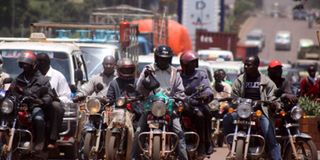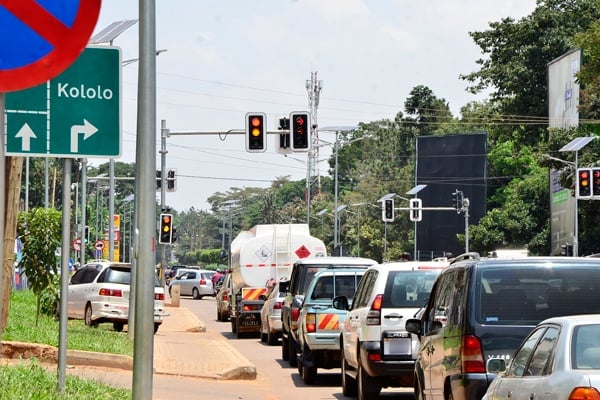Transition from boda bodas to buses

What you need to know:
- Once upon a time there used to be Uganda Transport Company (UTC)—but it is no more. When the National Resistance Movement (NRM) took power in 1986, with it came the proliferation of fourteen seater taxis (matatus)
- Taxi transport is unprofessional, lacking in customer service and has become archaic.
Tuesday, January 16, was the second day of the three-day East Africa Trade & Investment Forum at Kampala Serena Hotel, a conference that was held on the sidelines of the 19th Summit Non-Aligned Movement (NAM) at the newly-opened Speke Resort Convention Centre in Munyonyo.
That Tuesday morning, as I was walking briskly up the hill along Nile Avenue, on my way to Serena, from Uganda Media Centre, on Clement Hill Road, as I was crossing Hannington Road, a boda boda rider came speeding out of nowhere, turning the corner at full speed.
Instead of looking straight ahead, he had his face turned to one side, so he didn’t really see me crossing the road and avoided knocking me by a whisker! I have witnessed this kind of reckless riding several times. As I hurried up the hill to Serena, I wondered whether any boda boda rider operating in Kampala has ever read ‘The Highway Code’ handbook, published by the Ministry of Works and Transport, which clearly states you must always slow down when turning at corners or junctions.
Quite frankly, one has to have eyes in the back of one’s head, when one is crossing Kampala roads (or any road in Uganda for that matter) where boda bodas prevail.
They are ‘untouchable’ a law unto themselves, they have free reign of the roads, flout traffic rules, ride the wrong way against traffic, ride on traffic islands, ride on pavements, park on pavements, park at street corners, set up stages anytime and anywhere, do not stop at pedestrian crossings, inconvenience pedestrians, carry two passengers, ignore the speed limit and endanger lives—as traffic police officers look on oblivious.
Once upon a time there used to be Uganda Transport Company (UTC)—but it is no more. When the National Resistance Movement (NRM) took power in 1986, with it came the proliferation of fourteen seater taxis (matatus). Presently, Uganda’s mass public transportation system is privatised. That is the irony; our public transportation system is privatised, privately-owned by businesspeople, which opens the door wide open for exploitation when passengers are overcharged. It is a known fact that when transport fares go up in Uganda, they never go back down. They are always steadily on the increase.
Passengers are at the mercy of the forces of ‘demand and supply’ and the whims of transporters, which basically means taxi operators can do as they please and charge you whatever they want. Taxi transport is unprofessional, lacking in customer service and has become archaic.
We’ve had taxis since the 1980s! This transport fare exploitation reaches its peak every year during Christmastime, when some upcountry bus companies double or even triple fares for passengers who are travelling upcountry to their villages. At Serena, a presentation was made by Uganda Investment Authority (UIA) to pitch various investment opportunities in Uganda’s economy where investors from: Turkey, Egypt, United Kingdom, UAE, Bulgaria, Kenya, Tanzania and Thailand who were present at the forum could invest. The question was posed, “Why Uganda?” Various sectors such as minerals value addition, housing, commercial agriculture, agro processing and agroindustry, tourism, services were proposed; but the sector I would like to focus on is infrastructure development, under which falls the Bus Rapid Transit Project estimated to cost USD $424 million, ‘The project involves the construction of bus lanes, with median and exclusive rights to the BRT buses’.
Alongside this project is the Greater Kampala Light Rail Mass Transit System estimated to cost USD $ 1 billion. Rail is complementary to buses because one relieves the other, providing an alternative for passengers and reduces traffic jams on city roads.
Where is the investor for the Bus Rapid Transit Project? May God send the investor soon! However, I think bus fares should be subsidised by the government (so transport fares are kept low and affordable to all) and rather than having a plethora of different bus companies, each charging their own fares, as they ply the capital city routes. The city bus system should have set fares and be run by one, central government system, for example, Kampala Capital City Authority Buses.
Ugandans yearn for a professional bus transportation system that operates with drivers and conductors who wear uniforms; one with bus stops that follows a timetable, so passengers can plan their journey in advance; one that uses travel cards so passengers can pay for a daily, weekly, or monthly travel card, so the conductor does not have to grapple with change.
If we had such an organised public transport system, replacing taxis and bodabodas, many Kampala car owners would park their cars at home during the week and drive less frequently, which would automatically reduce the number of vehicles on the road and solve the traffic jam problem.
Josepha Jabo,




